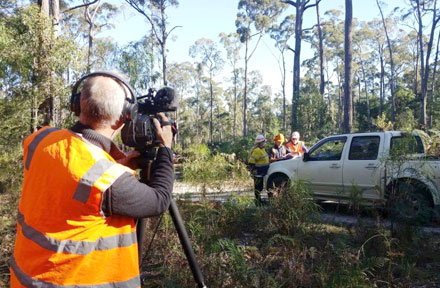
A recent article in ‘The Age’ shows how easy it is for the mainstream media to feed negative perceptions about the native forest industry, according to forestry writer and consultant, Mark Poynter. By Philip Hopkins for Timberbiz
Mr Poynter, in an address to the National Timber Councils Association conference, said the article was headlined “Timber industry bid to prove its green credentials falls flat”.
Key statements in the article were:
- Bunnings pressured VicForests into seeking Forest Stewardship Council certification to prove they are harvesting timber in an environmentally and economically sustainable manner.
- The FSC auditors have rejected VicForests bid to obtain certification.
- Bunnings has zero tolerance for illegally logged timber and wants to ensure that all of the wood products which it sells come from well managed forests.
Mr Poynter said most readers would get the impression from the article that timber production in Victoria’s forests was poorly regulated, could be illegal and was probably environmentally and economically unsustainable.
“But when you consider what the article didn’t say, you can come away with a completely different and far more balanced appreciation of the reality,” he said.
VicForests is already certified by the Australian Forestry Standard (AFS), which is recognised by the globally accepted Program for the Endorsement of Forest Certification (PEFC), an international, non-government organisation that promotes sustainable forest management.
Mr Poynter said AFS was not some ‘mickey mouse’ standard. Around the world, more forest was certified to PEFC standards than FSC, which green NGOs originally developed for tropical forests.
“In Australia, the environment movement is effectively the gate-keeper of who gets FSC certification,” he said. This had at times included threats to attack the reputation of retailers unless they sold only FSC wood products.
Mr Poynter said due to its complexity and time or space constraints, the city-based mainstream media tended to simplify its reporting of forestry issues.
“As that process almost always creates publicity that reflects badly on timber production, there are long-standing concerns about the media’s motivation and its lack of independence in relation to forestry issues,” he said.
“Regional media’s coverage of forestry is typically more balanced as it operates in closer proximity to the issues and those who live and work with them.”
In recent years in Victoria, Mr Poynter said scientists had been more active in media reporting of forestry issues, such as advocating for a proposed ‘Great Forest National Park’ in Victoria’s Central Highlands. Some had even become public advocates to close the timber industry.
Scientists’ opinions should be welcomed, but this depended on scientists being truly objective and impartial, and on the full array of relevant science being made available to the public.
“Unfortunately … only a sub-set of the science about forest conservation in the Central Highlands is being referred to by the media, much of it flawed,” he said.
However, the media automatically accepted what scientists said as irrefutable, especially when it was pro-environment.
Mr Poynter cited several examples of scientific research into the Central Highlands. One claimed that the Mountain Ash forests were critically endangered.
“In fact, these forests still occupy 97% of their pre-European range and two-thirds of it will never be used for timber production,” he said.
Other research claimed that closing the timber industry would reduce carbon emissions and mitigate climate change.
Mr Poynter said this view misunderstood the nature and extent of timber harvesting and was at odds with the International Panel on Climate Change(IPCC).
The IPCC regarded sustainable timber production as one of the solutions to reducing carbon emissions.
“Wood products are the only renewable building material,” he said.
There were many misperceptions due to the advocacy of some scientists, such as that the “Great Forest National Park’ was essential to save Leadbeater’s Possum.
“In fact, the overwhelmingly greatest threat to the possum is severe bushfire and simply declaring a national park will do nothing to address it,” he said.
Closing the timber industry was more likely to increase the fire risk by reducing road access into the forests and taking away a big chunk of the most experienced frontline fire fighters.
Mr Poynter said some scientists routinely claimed that timber production was ruining Melbourne’s water supply. However, only 12% of the forested water supply catchments was available for timber production.
About 200 hectares of the 157,000ha of forest (about 0.12%) was harvested and regenerated each year.
“Studies have shown that this has a negligible impact on water quality and quantity,” he said.
Another argument by scientists was that the Central Highlands timber industry could be replaced by eco-tourism.
“In fact, the Central Highlands forests are one of the coldest and wettest places in southern Australia where few people venture for at least a third of each year,” he said.
Forest-based eco-tourism could at best be only seasonal, whereas a 2015 study found that the Central Highlands timber industry generated $570 million in economic activity per annum and employed more than 2100 workers.
Mr Poynter said timber was a great asset and architects were demanding high quality hardwood timber.
“The native forest timber industries… which could supply this wood, have already been so diminished that they are now in the precarious position of perhaps being only one election cycle away from disappearing,” he said.





